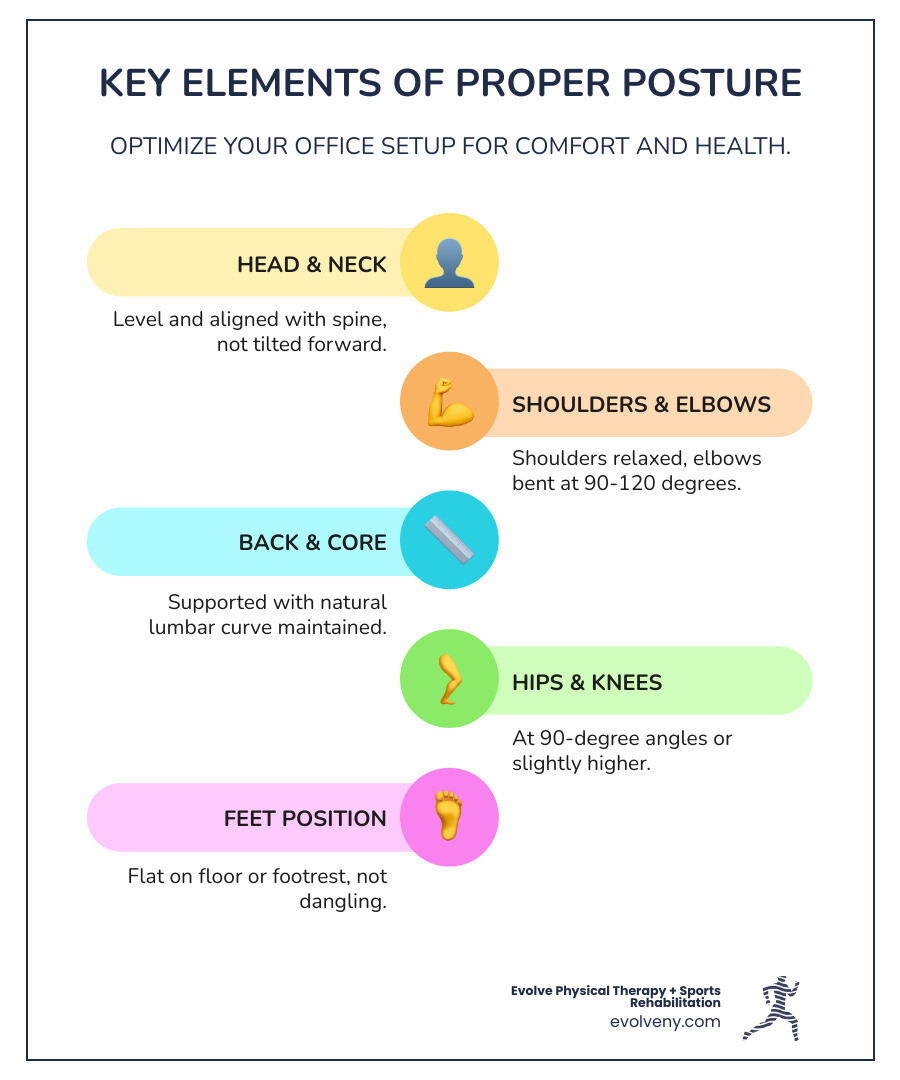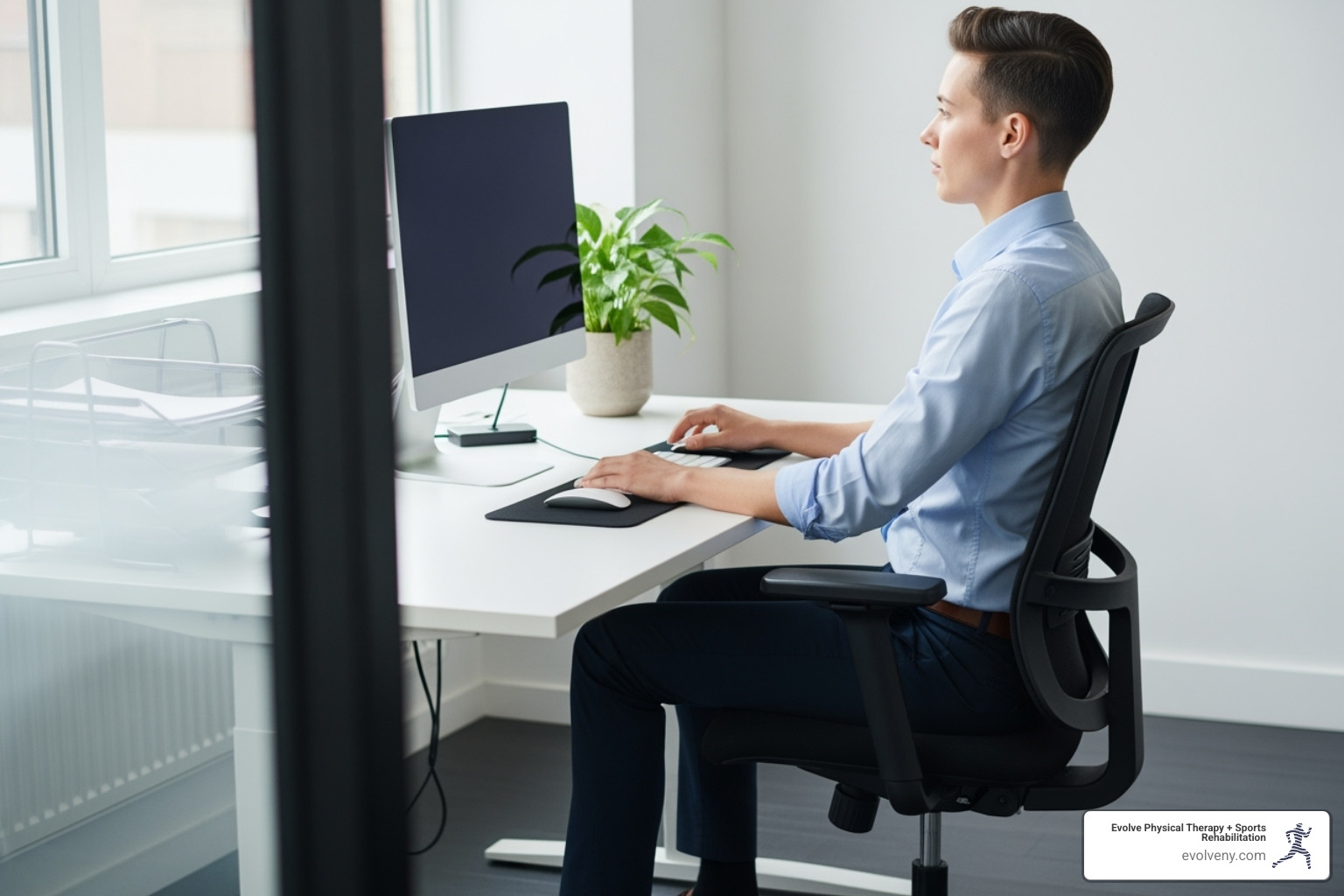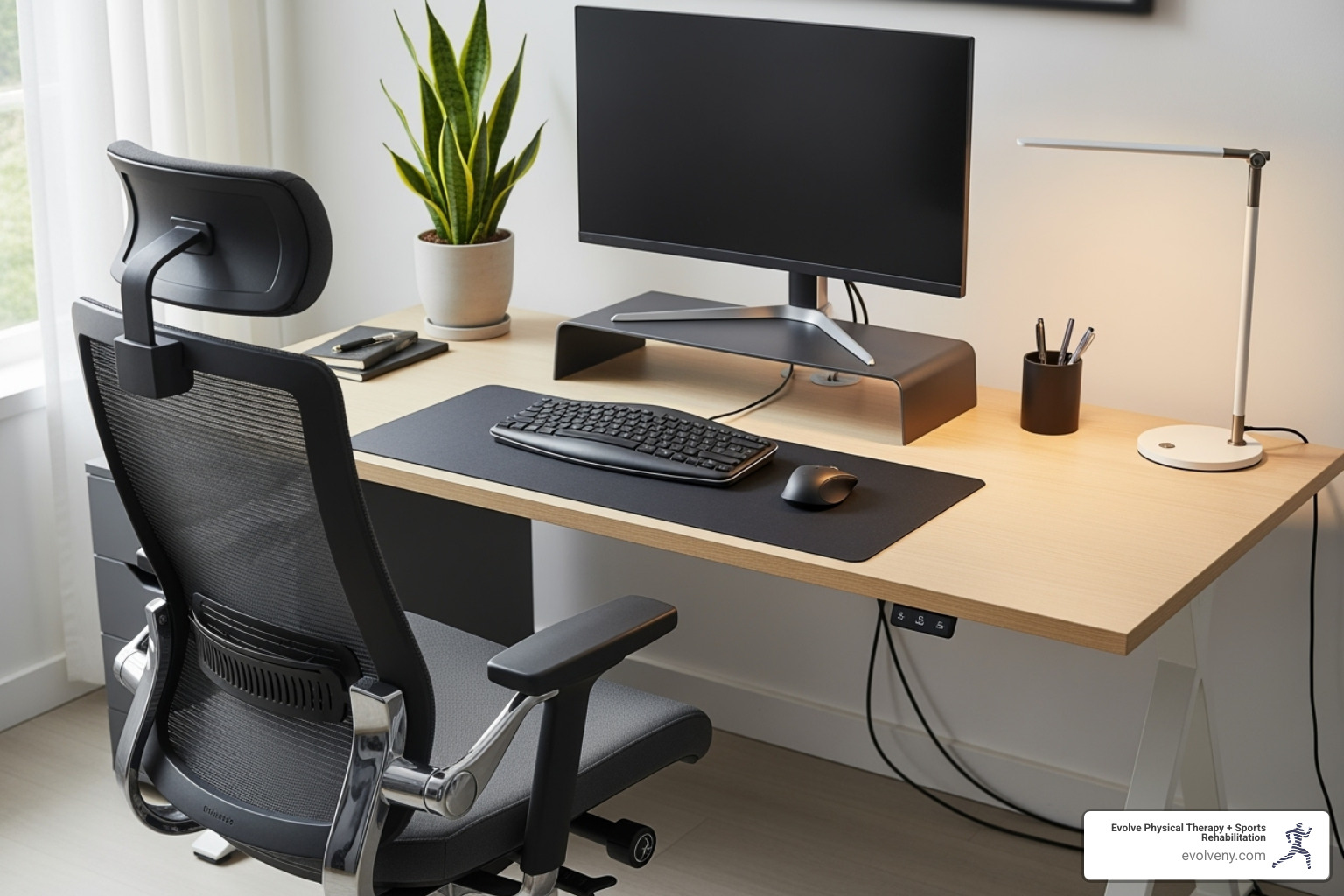Sit Right, Feel Bright: Mastering Office Work Posture
Why Office Work Posture Matters More Than You Think
Office work posture affects millions of workers who spend much of their day seated, leading to health issues beyond simple back pain.
Key Elements of Proper Office Work Posture:
- Head: Level and aligned with spine, not tilted forward
- Shoulders: Relaxed and even, not hunched or rolled forward
- Elbows: Bent at 90-120 degrees, close to your body
- Wrists: Straight and neutral, not bent up or down
- Back: Supported with natural lumbar curve maintained
- Hips and Knees: At 90-degree angles or slightly higher
- Feet: Flat on floor or footrest, not dangling
The statistics are sobering: for every inch your head moves forward from proper alignment, your neck bears an additional 10 pounds of stress. Poor posture doesn't just cause neck and back pain; it can reduce lung capacity, disrupt digestion, and increase your risk of diabetes and cardiovascular disease.
The good news is that good posture is within your control. Sitting correctly reduces unnecessary strain on muscles and joints, boosts your energy levels, and can improve your focus and productivity.
As Lou Ezrick, founder of Evolve Physical Therapy, I've spent nearly two decades helping patients overcome chronic pain rooted in poor office work posture habits. Through my work with hundreds of desk workers, I've developed practical strategies that address the root causes of postural dysfunction, not just the symptoms.

The Hidden Dangers of Your Desk Job
Poor office work posture creates a domino effect of health problems. Spending hours hunched over a keyboard or slumped in a chair takes a toll on your body in ways you might not realize.
Back pain is often the first warning sign. Slouching flattens your spine's natural curves, putting immense pressure on discs and ligaments. This can lead to disc degeneration and chronic discomfort.
Your neck also suffers. For every inch your head juts forward, your neck muscles work 10 pounds harder, leading to "tech neck." This persistent ache and stiffness from looking at screens can cause chronic neck strain and trigger tension headaches.
Poor posture affects more than muscles and joints. Slouching compresses abdominal organs, causing digestion issues and slowing metabolism. It also reduces lung capacity by shortening frontal muscles, making deep breaths difficult. Less oxygen means lower energy and reduced brain function.
Most concerning is the increased risk of chronic disease. Prolonged sitting and poor posture are linked to a higher risk of diabetes and cardiovascular disease. Our bodies are designed for movement, and a sedentary lifestyle works against our biology.
The science behind these risks is eye-opening. You can explore more about the health risks of sitting to understand just how serious these issues can become. And if you're wondering about the state of your own neck alignment, take a moment to consider Have You Checked Out Your Neck Curvature Lately.

Common Mistakes That Ruin Your Office Work Posture
It's easy to slip into habits that wreck our office work posture. These mistakes gradually become your new normal.
Slouching is the most common mistake. Collapsing your spine into a C-shape stresses discs and ligaments and can compress nerves, causing radiating pain.
Forward head posture ("tech neck") occurs when you lean forward to see your screen. This strains your neck and upper back muscles and is extremely common among office workers.
Crossing your legs feels comfortable but can cause problems. It can compress nerves, leading to numbness, misalign your hips, and restrict blood flow.
Dangling feet put pressure on the backs of your thighs and disrupt alignment up your entire body. Proper support for hips and knees is essential.
Reaching for your mouse or keyboard due to an improper setup leads to shoulder shrugging, leaning, and can cause repetitive strain injuries.
Cradling your phone between your ear and shoulder is a direct cause of neck and upper back pain, as the muscles aren't meant to hold that position.
The good news is that recognizing these patterns is the first step toward fixing them. For a deeper dive into identifying and correcting these common issues, check out our detailed guide on Bad Office Posture.
The Ultimate Guide to Proper Office Work Posture
Let's focus on what proper office work posture should look like. It's your body's natural sweet spot, where everything aligns without strain. The goal isn't a rigid, military-straight spine. Instead, we aim to maintain its natural curves with balance and support.

Your head should be level and balanced directly over your shoulders, not jutting forward. Imagine a string pulling your head upward, aligning your ears, shoulders, and hips.
Your shoulders should be relaxed and even, not hunched. Roll them back and let them settle naturally.
Keep your elbows close to your body, bent at 90 to 120 degrees. This supported position allows your forearms to rest gently on your desk.
Wrists and hands must stay in a straight line, not bent up, down, or sideways. Your hands, wrists, and forearms should form one continuous unit.
For your back, sit all the way back in your chair to maintain the natural curve in your lower back. Good lumbar support is crucial and should feel like a gentle pressure in the small of your back.
The 90-90-90 rule applies to your lower body: aim for 90-degree angles at your hips, knees, and ankles. Your thighs should be parallel to the floor.
Finally, your feet should rest flat on the floor or a footrest. This stable base supports your entire posture.
Proper alignment makes sitting feel effortless, as your muscles aren't fighting gravity. For a deeper dive into achieving this ideal setup, check out our comprehensive guide on Ideal Desk Posture.
Perfect posture isn't about being rigid—it's about finding a balanced, supported position where your body can work comfortably for hours.
Building Your Ergonomic Oasis: A Step-by-Step Setup
An ergonomic workspace isn't about fancy equipment; it's about setting up your environment to support your body's natural alignment. A correct setup means less strain, more comfort, and better focus.
Proper office work posture requires the right foundation. Your workspace should work with you, not against you. When everything is positioned correctly, you'll notice less strain, more comfort, and the ability to focus on your work instead of constantly shifting positions.

The Mayo Clinic provides excellent guidance in their comprehensive office ergonomics how-to guide, and if you're working from home, our dedicated insights on Home Office Ergonomics can help you create an ideal setup in any space.
Chair Adjustments for Optimal Support
Your office chair is your foundation. Most ergonomic issues can be solved with a few simple adjustments.
- Seat height: Adjust so your feet are flat on the floor and knees are at a 90-degree angle. Your knees shouldn't be higher than your hips. A height of 16-21 inches works for most.
- Lumbar support: It should maintain your lower back's natural inward curve. If your chair lacks support, use a cushion or rolled towel.
- Armrests: Set them so your shoulders are relaxed, with elbows close to your body and bent at 90-120 degrees. If they're too high you'll hunch; too low and you'll lean.
- Seat depth: Sit all the way back and ensure a two-finger gap between the seat edge and the back of your knees for good circulation.
Desk, Keyboard, and Mouse Placement
With your chair adjusted, set your desk height so your forearms are parallel to the floor when typing. If your desk isn't adjustable, raise your chair and use a footrest.
Place your keyboard directly in front of you, 4-6 inches from the desk edge, to keep wrists straight. The mouse should be right next to it to avoid reaching.
Use wrist rests only for breaks, not while typing. Let your wrists float to prevent pressure on nerves that can lead to carpal tunnel syndrome. For detailed guidance, our article on Correct Computer Posture walks you through the specifics.
Monitor Positioning to Prevent Neck Strain
Your monitor position is critical for good office work posture and preventing neck pain.
- Position: Place your monitor arm's length away (20-40 inches).
- Height: The top of the screen should be at or just below eye level.
- Centering: Center the monitor directly in front of your keyboard to avoid twisting your neck.
- Bifocals: If you wear them, lower your monitor an extra inch or two to avoid tilting your head back.
- Laptops: The screen is too low and the keyboard is cramped. Use an external keyboard, mouse, and a laptop stand or separate monitor.
Accessories like footrests, back cushions, and monitor stands are problem-solvers that help ensure proper foot placement, lumbar support, and screen height.
Maintaining Good Habits for Lasting Comfort
A perfect ergonomic workspace is just the start of improving your office work posture. Real change comes from weaving healthy movement into your daily routine. Your body is designed for movement. Staying static for hours, even in an ideal setup, creates tension, reduces circulation, and encourages slouching.
Adopt the 30-minute rule: every half hour, take a brief break to stand, walk, or stretch. This regular movement prevents stiffness, improves blood flow, and resets postural muscles. Find a consistent rhythm that works for you.
A sit-stand desk is a great tool for alternating between sitting and standing. This reduces the static load on your spine, but variation is key—don't just stand all day.
Micro-movements also help. While seated, shift your weight, adjust your chair, or stretch your fingers and wrists to prevent your body from getting locked into one position.
For more comprehensive strategies on building these habits into your routine, check out our guide on Good Posture for Office Workers.
Simple Stretches to Improve Your Office Work Posture
Regular stretching resets your office work posture. These desk-friendly movements counteract the effects of prolonged sitting.

- Neck rolls: Relieve tension from screen time. Gently bring your ear toward each shoulder and do chin tucks to combat "tech neck."
- Shoulder shrugs: Release tension in your upper back. Lift your shoulders to your ears, hold, and then release.
- Torso twists: Improve spinal mobility. While seated, gently rotate your upper body to one side, using the chair for support, then repeat on the other side.
- Wrist stretches: Help prevent repetitive strain injuries. Extend your arm and gently pull your fingers back, first with the palm up, then down.
- Upper back stretch: Counteracts hunching. Clasp your hands and push forward, rounding your upper back. You can also interlace fingers behind your head and open your elbows to stretch your chest.
These stretches improve flexibility, boost blood flow, and remind your body what good alignment feels like.
The Role of Professional Guidance
Sometimes, despite your best efforts, you may need professional support for your long-term comfort and health.
When should you see a specialist? Seek professional guidance for persistent pain, numbness, tingling, or weakness that doesn't improve with self-care or interferes with your daily life.
How can physical therapy help? At Evolve Physical Therapy + Sports Rehabilitation, we go beyond symptoms. We start with a thorough posture assessment to find the root cause of your discomfort. Our physical therapists use hands-on techniques, targeted exercises, and education to correct imbalances. We focus on core stability, spinal alignment, and muscle re-education to retrain your body.
Our goal is lasting relief. We teach you custom corrective exercises and help you understand how your daily habits contribute to your discomfort. Physical therapy for posture training can be a game-changer. To learn more, explore our guide on Physical Therapy for Posture Training.
Frequently Asked Questions about Office Posture
Here are answers to common questions about improving office work posture.
How long does it take to correct years of bad posture?
Correcting years of poor office work posture takes time and patience. Consistency is key; daily practice is more effective than infrequent, longer sessions. Most people feel some relief within a few weeks. However, re-training neuromuscular patterns that have developed over years takes time. The gradual process involves becoming aware of your posture, strengthening supportive muscles, and stretching tight ones until good posture feels natural. With consistent effort, most people see significant improvements in 6-12 weeks.
Can a standing desk solve all my posture problems?
Standing desks are useful tools, but not a magic bullet. It's easy to adopt poor standing posture, such as leaning on one hip or hunching. The real benefit is alternating positions, as your body needs movement. Proper standing posture is just as important as proper sitting posture: distribute weight evenly, keep knees soft, shoulders relaxed, and core engaged.
Is it normal to feel some discomfort when first correcting my posture?
Yes. When you start correcting your office work posture, you're activating muscles that have been underused, which can cause some initial discomfort. Think of it like the soreness after a new workout. It's important to differentiate between good and bad pain. Good discomfort is mild muscle fatigue or soreness. Bad pain is sharp, shooting, or involves numbness and tingling.
When should you seek help? If discomfort persists for weeks, worsens, or feels sharp, consult a physical therapist to ensure you're making changes safely and effectively.
Take Control of Your Comfort and Health
Improving your office work posture is about more than sitting up straight; it's about reclaiming your energy, comfort, and quality of life. Prioritizing posture is an investment in feeling better every day.
The change can be remarkable: no more backaches or tension headaches, and more energy to enjoy your evenings instead of feeling drained. The benefits include reduced pain in your back, neck, and shoulders. You'll also experience increased energy levels as your body works more efficiently, and improved focus without the distraction of discomfort.
At Evolve Physical Therapy + Sports Rehabilitation in Brooklyn, we've seen these changes firsthand. Our approach is not about quick fixes; we empower you with the knowledge and tools for lasting change.
We meet you where you are, assessing your posture, workstation, habits, and pain patterns to understand your unique situation. We don't just treat symptoms; we help you understand the why behind your discomfort and provide practical, real-world strategies you can stick with.
Ready to finally feel comfortable at your desk? Learn more about how ergonomic physical therapy in Brooklyn can transform your workday. Your future self will thank you for taking this step today.


